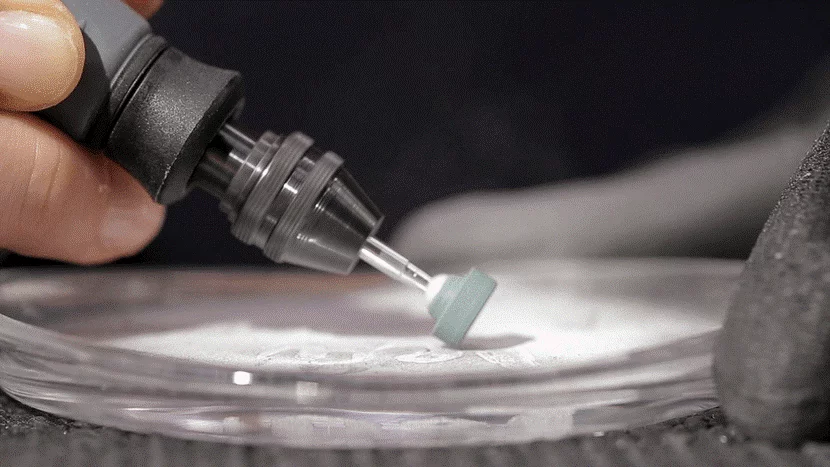Silicon carbide grinding stones are designed to sharpen, deburr, and handle overall grinding purposes. They are typically used to remove excess glaze & stilt marks, create sharp edges, and engrave on a glass. Compared to aluminum oxide points, they are incredibly tougher. This is because they are made, in particular, to be used on hard materials such as ceramics and glass. Let’s delve more into the silicon carbide grinding stone uses.
Silicon Carbide Abrasive
Silicon carbide, generally, is a unique ceramic material characterized by outstanding hardness. The only materials with better hardness compared to silicon carbide are cubic boron nitride, diamond, and boron carbide.
It’s an abrasive from the combination of silicon and carbon. Abrasive experts show that the material is extremely abrasion-resistant and relatively more cost-effective as far as production is concerned. Silicon carbide is lightweight, features great thermal conductivity, and comes with low thermal expansion. Due to these, it’s a material usually applied as a solid or loose abrasive material in numerous applications.
Silicon Carbide Stone
Have you heard of the term “carborundum stone?” If you haven’t, it may imply that you’ve not been sharpening your blades for quite a time.
In this present decade, this stone is hardly called carborundum because most people refer to it as silicon carbide stones.
Silicon Carbide (SiC.) is a binary compound of silicon and carbon. One of the common and popular types of this stone is Sharp Pebble 400/1000 grit whetstone. This stone is perfect when it comes to repairing blades with damaged edges or giving tools an excellent sharpening process.
As for color, the stone can be gray/black or green. For instance, Sharp Pebble 400/1000 Grit sharpening stone is designed with green silicon carbide. Most times, operators use silicon carbide stones for sharpening knives produced from tough stainless steel due to its quality of cutting aggressively.
Silicon Carbide Grinding
Silicon carbide theoretically is not different from stone abrasive and diamond grinding. The material features progressive textures (60-1000 grit). It’s designed to be used by operators in a progressive way to achieve the most preferable and best finish.
Nevertheless, there is a limitation in its ability to get rid of scratches and restore the high polish state of the stone. It’s virtually non-existent for removing lippage. Nonetheless, it remains an economical, moderate, and effective way of restoring a specific work piece.
Out of the three grinding methods, including grinding with diamond, stone abrasives, and silicon carbide disk, the first two methods ensure that stones are finished using buffing compounds, chemicals, or metallic elements. Unlike these two methods, the silicon carbide disks cannot offer excellent results on granites but can thrive on travertines and marbles. Aside from using diamond and stone abrasives, silicon carbide disks also work effectively to provide desired sharpness by grinding damaged stones properly.
Silicon Carbide Grinding Stone Uses
Silicon carbide grinding stones are the ideal tools when it comes to grinding and etching glass, stone, porcelain, ceramics, and non-ferrous metals.
The features of silicon carbide grinding stones include:
- They help sharpen, deburr and handle other grinding processes on harder materials.
- They are often used on glass, stone, porcelain, gemstones, ceramic, and non-ferrous metals.
- They are made to be used with conic and flat surfaces
- They are perfect for grinding and etching
Tips for Users
The following are the important tips you must observe if you intend to use silicon carbide grinding stones:
- You must ensure that you remember to get a charged spare battery pack. This is to prevent stopping while work is ongoing to get your battery recharged. Also, the cordless rotary tool should be kept well-charged before the grinding begins.
- It’s crucial that you insert an accessory bit into the rotary tool and back it slightly out before tightening it. This is to get the best results. Besides, it will offer a lot of shanks for the chuck or collet to hold onto the bit.
How to Use Silicon Carbide Grinding Stones for Grinding and Sharpening
For most Do-It-Yourself (DIY) projects, grinding and sharpening are essential skills. They are required to make bathroom tiles fit by shaping them, sharpening hedge shears for smooth or spring protruding screws, etc. For every beginner who is interested in the use of silicon carbide grinding stones for sharpening and grinding, there are vital steps you must take to have good results. Check below for the necessary information about the use silicon carbide grinding stones:
- Start with the fundamentals of grinding and sharpening
The first thing you should do after deciding to grind and sharpen your workpiece using silicon carbide stones is to know the basis of grinding and sharpening. Grinding and sharpening stools are designed for different objects, including glass, pipes, and tiles.
When grinding, your will need to smoothen rough edges or sharpen edges by focusing on achieving a sleek finish. This is different when sharpening, as your focus will be on creating a sharp edge or a thin point. So, it’s crucial that you get the appropriate tools that can handle both activities perfectly.
- Select the appropriate accessories
Do you want excellent grinding and sharpening results? Then you must opt for the accessory that suits the material you have selected. You have a good start if you can get your accessories right. For instance, green silicon carbide grinding stones are great for hard and non-ferrous materials (porcelain, ceramics, stone, and glass). This is because the stones ate exceptionally perfect and durable when it comes to engraving glass or removing stilt marks on ceramics.
- Know the safest way to work
While grinding and sharpening, your safety should be prioritized. It’s professionally advisable to use protective equipment such as a dust mask, safety glasses, gloves, and the Comfort Guard Attachment.
Naturally, you will be exposed to sparks and dust when grinding ferrous metals such as cast iron or steel. Fortunately, you can easily protect yourself from the particles by using protective glasses, which shield your eyes. A dust mask will protect you from breathing in tiny bits, while protective gloves ensure that your hands are optimally safeguarded. If your toolkits feature a Comfort Guard Attachment, it could also help deflect dust and sparks.
- Turn the Revolutions Per Minute (RPM) up
It’s recommended that the RPM be set to not less than 15000 and not more than 30000. To get impressive sleek results and perfect handling, you should observe this during the use of silicon carbide grinding stones.
You should note that too slow rotation speed can make the accessories start bumping, leading to dents or unevenness in your material or object. Therefore, don’t hesitate to put the speed to the test. Silicon carbide grinding stones and points can reach the speed of 20000 or 30000 RPM. But you need to check the instructions for each accessory to know what is required for safety reasons.
- Time for a golf grip
When grinding or sharpening, it’s essential to go for a secure grip for control and stability. You need good control during the process. And to get this with proper stability, a one- or two-handed golf grip is recommended. This will help ensure that the sharpening tools are kept at a reasonable level and that the grinding attachments are firm.
How can you do a golf grip?
- A one-handed grip: Use your dominant hand to hold the tool with your thumb right on top, pointing in the direction of the tool’s shaft.
- A two-handed grip: Use your weak hand to hold the tool, then place your dominant hand on it. But ensure that the thumb of the dominant hand overlaps the thumb of the weak hand–each thumb must be pointing in the direction of the shaft.
- Secure your tool or the object
During the use of silicon carbide grinding stones for grinding and sharpening, you must ensure that the tool or the object is secured in a vice for safety and stability.
There are two different ways to work safely and precisely on your object as you grind or sharpen your work piece. These include:
- You can use a vice or clamp to secure the object to the workbench safely. Work on the object by bringing the tool to it using a golf grip.
- You can use Multi-Vise to attach the Multi-Tool to the work surface securely and then work on the object by bringing the tool to it using both hands.
With a Multi-Vise, you can easily clamp and hold your tool. It supports rotating your tool in 360 degrees, allowing you to approach the object from any comfortable angle. But it’s crucial that you keep your hands away from sharp objects or moving accessories
- Choose the correct attachments
There are benefits attached to the use of the right tools and extra attachments. With this, you are assured of a very smooth grinding and sharpening project. Below are the correct extra tools and attachments you may want to consider:
- Multi-Vise (2500): This tool is designed to provide perfect stability. You can use it as a tool holder, stand-alone clamp, and stationary vice. To work from any comfortable angle, you can rotate and tilt the tool.
- Comfort Guard Attachment (550): This attachment will help keep you from dirt, rust, and flyaway particles.
- Chainsaw Sharpening Attachment (1453): This attachment will help with easy and rapid sharpening, irrespective of the size of your chainsaw.
- Shaping Platform Attachment (576): This attachment allows you to grind at two different perfect angles (45° and 90°).
- Time to work on your project
Get your Multi-Tool with your silicon carbide grinding stone attached and start to work. You can use the silicon carbide grinding stones to sharpen an ax and hedge shears. For grinding, you can use the stones to shape bathroom tiles, deburr a copper tube after cutting it, smoothen protruding screws, smoothen welded joints, and smoothen mosaic tiles after cutting them.
Conclusion
Silicon carbide grinding stones used with a rotary grinder will help you achieve impressive results when grinding and etching glass, stone, porcelain, ceramics, and non-ferrous metals. You should do your best to get the best product, but if you find it challenging, you may get in touch with us.

